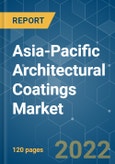The Asia-Pacific architectural coatings market is estimated to witness a significant growth, at an estimated CAGR of over 6%, over the forecast period. Increasing housing construction activities in the emerging economies of Asia-Pacific are expected to drive the market during the forecast period.
Key Highlights
- Rising environmental concerns and regulations in China and rise in prices of raw materials are likely to hinder the market’s growth.
- China is expected to dominate the market and is also expected to witness the fastest CAGR during the forecast period.
Key Market Trends
Rising Demand from Residential Construction
- Paints and coatings are extensively used in the architectural sector, for both exterior and interior applications. Modern advances in paint technology, specifically in the acrylic formulations, have offered a wide range of weatherproof coatings.
- Paints and coatings are applied on the exterior of the house to not only increase its aesthetic appeal, but also to protect it from blistering summers, freezing winters, soaking rain, and the daily bombardment of UV radiation, without fading, peeling away, and cracking.
- However, moisture causes problems for paint. Dew, rain, snow, and ice on the outside, or vapor and moisture buildup from the inside, can cause problems with exterior paint. When moisture penetrates the paint, blisters can form, and the paint may peel. Moisture blisters, unlike temperature blisters, go through all coats of paints down to the wood.
- Additionally, paints and coatings are also used in interiors of houses to add colors, or for decorative purposes, along with a wide range of other functions. Their functions vary, depending upon the type of environment and the room that they are used on.
- For example, due to the moisture, bathroom walls need to have wipe-ability, in order to keep them clean. Paints with glossier sheens have a tighter molecular structure than flat paints, making it more difficult for moisture to penetrate. Thus, these types of paints are used in bathrooms.
- The aforementioned factors have been boosting the demand for architectural coatings, in the recent times.
China to Dominate the Market
- In the Asia-Pacific region, China is the largest economy, in terms of GDP. China is one of the fastest emerging economies and has become one of the biggest production houses in the world, today. The country’s manufacturing sector is one of the major contributors to the country’s economy.
- The continuous improvements in economic conditions in the region have enhanced the financial status of the consumers, in turn, boosting the demand for buildings and other infrastructural activities in the country.
- China’s 13th Five Year Plan started in 2016 as it was an important year for the country’s engineering, procurement, and construction (EPC) industry. In addition to this, the country ventured into new business models domestically and internationally, during the year. Although the construction sector slowed down after 2013, it is still a major contributor to the GDP of the country.
- Moreover, restrictions on foreign investment on land development, high-end hotels, office buildings, international exhibition centers, and construction and operation of large theme parks have also been lifted. The growth in commercial and residential sectors is expected to boost the architectural coatings market in the country, over the forecast period.
Competitive Landscape
The Asia-Pacific architectural coatings market is partially consolidated. Key players in the market include Akzo Nobel N.V., Asian Paints, Jotun, Kansai Paint Co., Ltd., and Berger Paints India Limited, among others.
Additional Benefits:
- The market estimate (ME) sheet in Excel format
- 3 months of analyst support
This product will be delivered within 2 business days.
Table of Contents
Methodology

LOADING...








